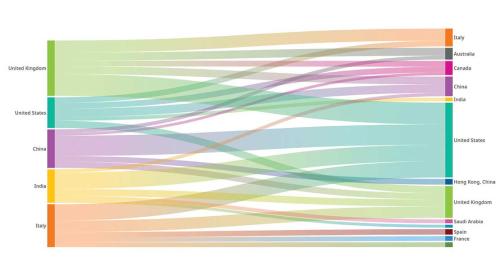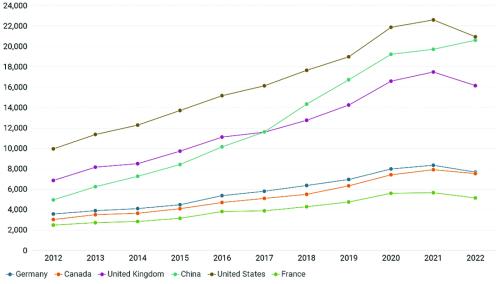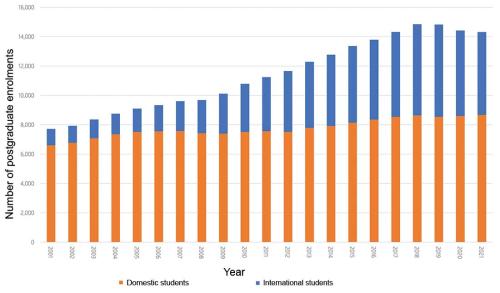The global science system is at its most valuable, and its most vulnerable. There are local challenges that each country’s scientists will need to solve, but the global challenges are different: bigger, harder and more complex, and political. They require global solutions, and that will require researchers and people to work together.
We face challenges from technologies born of science that were recently the stuff of dystopian Hollywood imagination – artificial intelligence, advanced robotics and quantum. And while they too demand collaborative science to deliver answers to government and society, they have fast become matters more characterised by strategic national competition than collaboration. But collaboration is a matter of strategic national interest, for everybody.
We in Australia can’t do without international collaboration either. Our size and location make that obvious. We have to be willing and able to contribute to the knowledge bank that will help solve the challenges, and we need our scientists to be there when the big decisions are made that affect us and that affect the living systems in all other countries. We share one planet; we have nowhere else to go.
How do we in Australia navigate the next few months and years? How do we facilitate strategic collaboration?
The answers may well be among the most significant decisions we make as a nation. They will dictate our contribution to meeting global challenges. They will determine whether we develop the sovereign capabilities needed to secure our nation and globe. They will determine whether science is:
- adequately equipped to serve the national interest
- open enough to develop the technologies we need
- open enough to access the 96% of knowledge we don’t generate
- protected enough to ensure our knowledge and capabilities do not fall into foul hands.
It’s a conundrum of global proportions, and my own field of scientific endeavour illustrates why.
My work in nanotechnology and semiconductors – an area of strategic competition between nations – is fuelled by my research group, which is entirely made up of international students. My work is also made possible because of some 30 collaborations I maintain across the world, spanning countries including the UK, the US, India, China, Germany, France, Sweden, Finland, Norway, Italy, the Netherlands, Japan, South Korea, Russia, Lithuania, Poland, Brazil, South Africa ... and the list goes on.
My work is fundamental discovery research, designed to better understand our world at a nanoscale. To put this into perspective, I can place 20 lasers in one strand of your hair. Why would I want to do that? Because at the nanoscale, I can create technology to better diagnose disease and understand and treat Alzheimer’s disease in the longer term. I can create technology that more efficiently runs solar cells and generates hydrogen as a sustainable fuel source needed to decarbonise our industries and economy.
The trouble is, my research is also listed on the Defence and Strategic Goods List. Category 6, specifically 6A004, 6A005, 6A007 … the number soup goes on. And this means, placed in the wrong hands, my research could be used for less than desirable purposes.
On 7 November 2023, a new piece of legislation was released designed to strengthen Australia’s defence export control framework so it keeps pace with the emerging challenges in Australia’s security environment. The Exposure Draft of the Defence Trade Controls Amendment Bill 2023 proposes to strengthen our defence export control framework by, among other things, creating three new criminal offences in the Defence Trade Controls Act 2012.
It says I can collaborate freely with the US and the UK – which certainly has its benefits – but I would require an approved permit prior to collaborate with other foreign nationals. Without it, my collaborations would see me jailed. So, it expands Australia’s backyard to include the US and the UK, but it raises the fence.
For my research group, which consists entirely of PhD students, postdocs, technicians and senior researchers from countries other than the US and the UK, we will need permits for all that we do. And members of my group will need to operate in a closed environment to not unintentionally share knowledge that may have a dual use.
Discussion at international conferences, where unpublished knowledge is shared freely to solve research problems and enable collaboration, seems unlikely if this bill becomes law. Some of this may still be technically legal under this new legislation, but how will I know which session of these conferences I will be able to present at, ask questions or engage in discussions with or without a permit? My ability to attract the best and brightest in the world, wherever they are, will diminish.
It’s timely to ask what Australia is really seeking to secure if we are restricting the development of technologies that are critical for our country. In my experience and the experience of researchers worldwide, the best research is global. But, to comply with the new laws I will have to lock down my communications and restrict my collaborations.
It feels like I am being asked to create something akin to the US’ federally funded research and development centres or university-affiliated research centres, minus the funding. These centres are not-for-profits that are established and funded to meet long-term engineering, research, development and analytical needs, like the Lincoln Lab at MIT. They are a mechanism used in the US to control risk but not limit collaboration for critical innovation.
If such structural change in the research architecture and system is required to address national security concerns, the Australian Government will need to consider the resource implications of implementing such changes:
- resources to establish secure research facilities
- resources to educate and train the workforce on the changing Defence and Strategic Goods List
- resources to foster a more security-aware culture across the research sector
- resources to facilitate compliance.
They will also need to accept the limitations of compliance. Students live in shared houses and university colleges; they go to cafes and to the student union. They don’t only talk about the weather or the latest episode of their favourite show on Netflix. It’s natural to share what they do – perhaps vent a frustration, seek reassurance about a doubt or celebrate a success.
We all do it because we are human. It ought not to be a jailable offence.
So, there is a lot at stake as we revise the architecture of our research system to respond to security threats. I am the first to agree that we need to do something to the changing geopolitical environment we need to operate in. But we ought not to throw the baby out with the bathwater. Australia is the product of the freedom of movement of scientists and our ability to collaborate and welcome talent to our shores.
Today, we have a National Reconstruction Fund, with a stated ambition to diversify and transform Australia’s industry and economy. We are still 93rd in the world in terms of our economic complexity. In other words, we have a vulnerable economy that is underpinned by too few exports and industries, key among them unprocessed natural resources. So, more than ever, we need to diversify our industrial base and build onshore capabilities.
With these imperatives in mind, it is not a time to impede collaboration. Why? There is perhaps no better recent example of the benefit of international science collaboration than the development of COVID-19 vaccines. While the science behind mRNA was decades in the making, getting a vaccine to market in less than 12 months was a stunning achievement.
Take a look at Figure 1: on the left are the five countries that led in COVID-19 research efforts, and on the right are the countries they collaborated with the most. Australia is there on the right, having the most research publications with the UK and China.
Consider global efforts to develop large-scale infrastructure beyond the capacity of any one country, like the Square Kilometre Array (SKA). The SKA Observatory is one global observatory over two sites in South Africa and Australia, with associated data-processing facilities. It is achieved through a collaboration of member states and institutions, including Australia, China, Italy, the Netherlands, Portugal, South Africa, Spain, Switzerland and the UK. They collectively provide resources and knowledge, and industrial, technical scientific and policy experience, to realise the SKA.
Chinese industry and scientists have contributed to engineering design and development work. Their know-how and technology are built into this global infrastructure. We have been able to provide safeguards without erecting high fences.
Australian businesses are benefitting from the economic opportunities of being a host nation. And history has shown us that when we better understand the universe and its origins, it leads to unforeseen technological developments like wi-fi. Understanding our universe deepens our understanding of the fragility of Earth’s ecosystems and helps us respond to variations to it. It enables our communications. The list goes on.
Could we achieve any of our innovations and competitive edge without collaboration? No. Let’s be clear: the last major Australian invention that did not involve international input was the stump-jump plough. That was 1876. When we collaborate, we are stronger.
Let’s look at Australian research trends over time. Australia is a relatively small market – 0.3% of the world’s population – with low investment in R&D, by international standards, at 1.68% of our GDP. This has been falling for several years and is now well below the OECD average. Australia and Oceania together account for only 1.1% of the world’s investment in research and innovation, a level that is dwarfed by the world’s science superpowers – the US (29%), China (37%) and Europe (22%).
We are a middle-power science nation. Despite this, we are prolific collaborators with significant influence in global science for our size. Looking at our share of global science, we contribute 3.5% of the world’s research and 7% of the world’s most highly cited research. Australia is ranked ninth globally in the volume of scholarly outputs and sixth globally in citations. Australian scientists’ proportion of the top 10% of cited publications involving international collaboration has risen more sharply than the OECD average.
It is indisputable – international collaboration is the norm for researchers in Australia. Ninety per cent of the top 50 cited papers from Australian authors in the Web of Science (2013–2023) were co-authored with overseas collaborators. Eighty per cent of Australian Research Council Discovery projects in STEM fields awarded in 2022 involved international collaborations.
Australia’s patterns of international scientific collaborations are wide and diverse. We collaborate with almost every country in the world, with collaborations involving the US and the UK being particularly strong. Collaborations with China have grown in recent decades, and it is now among our most important international partners. Figure 2 shows how our scholarly outputs with China have increased steeply over the past decade.
Who does the research in Australia? Our higher education sector and research workforce are also highly international. In the natural and physical sciences, the number and proportion of overseas students has grown over the past two decades (Fig. 3). In 2021, 39% of natural and physical sciences postgraduate research student enrolments in Australia were overseas students.
Overall, international students represent 36% of Australia’s postgraduate research students, who make up nearly a quarter of our research workforce and drive much of the original research conducted in Australia. In 2022–23, the top five citizenship countries for postgraduate research sector student visas granted were China (18%), India (9%), Saudi Arabia (9%), Sri Lanka (7%) and Bangladesh (7%).
The “professional, scientific and technical” industry is the biggest user of temporary skilled visas. In 2020–21, universities sponsored 320 university lecturers and tutors. Let’s not forget that universities rely on international student fees to remain financially viable.
The bottom line is that supporting international scientific collaboration is in Australia’s national interest – perhaps just as much as strengthening our security is in our national interest. International research collaboration does provide challenges to national security, but it also contributes to maintaining it.
Today, the global science system is more vulnerable than it has ever been due to decisions taken by states as they respond to security challenges. So, we must tread carefully and with eyes wide open when presented with proposals that restrict our international scientific engagements. We must carefully weigh up the benefits and the costs of de-risking our research environment. And we must always take an evidence-informed approach.
There is too much at stake to do otherwise.






